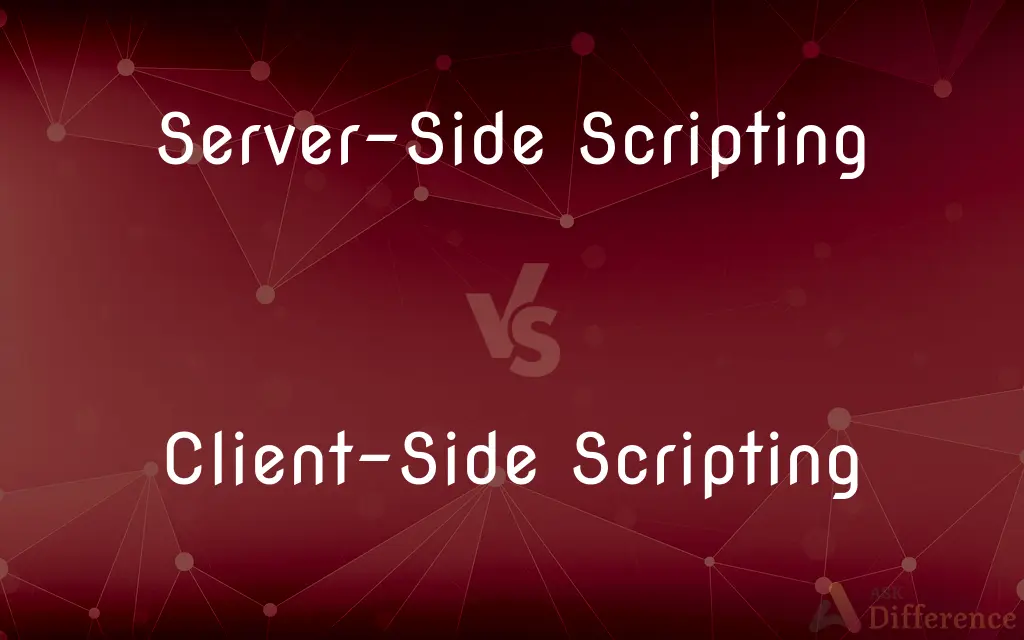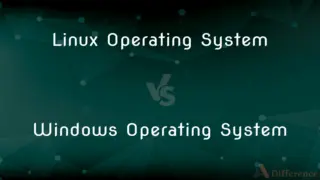Server-Side Scripting vs. Client-Side Scripting — What's the Difference?
By Tayyaba Rehman & Urooj Arif — Published on January 31, 2024
Server-side scripting runs on a web server, handling backend tasks like database interactions, while client-side scripting runs in the user's browser, controlling the UI and user interactions.

Difference Between Server-Side Scripting and Client-Side Scripting
Table of Contents
ADVERTISEMENT
Key Differences
Server-Side Scripting refers to scripts executed on a web server, handling tasks like database management, server configuration, and page generation. Client-Side Scripting, conversely, involves scripts that run in a user’s web browser, dealing with user interface elements and interactive features.
In Server-Side Scripting, scripts are processed on the server, and only the resulting output is sent to the client. In contrast, Client-Side Scripting involves scripts that are downloaded and run on the client’s machine, allowing for dynamic interaction without server communication.
Server-Side Scripting is used for creating customized web pages, handling form submissions, and accessing databases. Client-Side Scripting is utilized for enhancing user experience by enabling interactive content, real-time updates, and responsive web design.
Server-Side Scripting languages include PHP, Python, Ruby, and ASP.NET. Client-Side Scripting mainly involves JavaScript and frameworks like Angular, React, or Vue.js.
Security in Server-Side Scripting is crucial as it involves direct access to the server and databases, while in Client-Side Scripting, security focuses on preventing attacks like XSS (Cross-Site Scripting).
ADVERTISEMENT
Comparison Chart
Execution Location
On the web server
In the user's web browser
Primary Languages
PHP, Python, Ruby, ASP.NET
JavaScript, along with HTML and CSS
Main Functions
Database access, page rendering
UI dynamics, user interaction
User Experience Impact
Generates customized content
Enables interactivity and real-time updates
Security Concerns
Focuses on server and data protection
Focuses on preventing browser-based attacks
Compare with Definitions
Server-Side Scripting
This scripting is invisible to the end-user and provides backend functionality.
A Python script running on a server performs data analysis and sends results to the front end.
Client-Side Scripting
It directly affects the user experience by manipulating HTML and CSS.
A client-side script animates a dropdown menu using CSS transitions.
Server-Side Scripting
Server-Side Scripting is used for tasks like database manipulation and server configuration.
A Ruby on Rails application updates user information in the database.
Client-Side Scripting
Client-Side Scripting enhances interactivity and responsiveness of websites.
A JavaScript function validates a form input before submitting it.
Server-Side Scripting
Server-Side Scripting languages include PHP, Python, and Ruby.
A server-side script written in Node.js processes an API request.
Client-Side Scripting
It is primarily done in JavaScript and frameworks like React or Angular.
A React script updates the user interface based on the state changes.
Server-Side Scripting
Server-Side Scripting involves programming on the server to generate dynamic web pages.
A PHP script retrieves user data from a database to display a personalized dashboard.
Client-Side Scripting
Client-Side Scripting enables dynamic web content and real-time updates.
AJAX allows a webpage to update user comments without refreshing the page.
Server-Side Scripting
It processes user requests on the server and sends back HTML responses.
An ASP.NET application processes a login form and returns a success page.
Client-Side Scripting
Client-Side Scripting is coding that runs in a web browser for interactive user interfaces.
JavaScript changes the content displayed on a webpage without reloading it.
Common Curiosities
What is Server-Side Scripting?
Server-Side Scripting involves scripts that run on a web server to generate dynamic web pages.
Can Server-Side Scripting work without a web server?
No, Server-Side Scripting relies on a web server to execute scripts and serve dynamic content to clients.
Is Server-Side Scripting suitable for client interactivity?
Server-Side Scripting is not ideal for real-time client interactivity; it's mainly used for generating dynamic web pages.
What are the security considerations for Server-Side Scripting?
Security is crucial, as server-side scripts can access sensitive data. Proper input validation and authentication are essential to prevent vulnerabilities.
What is a common use case for Server-Side Scripting?
E-commerce websites often use Server-Side Scripting to manage product catalogs, user accounts, and transactions.
What is Client-Side Scripting?
Client-Side Scripting involves scripts that run in a user's browser to manage UI and interactivity.
What is a primary use of Client-Side Scripting?
It's used to create interactive and dynamic user interfaces on websites.
Can Client-Side Scripting work without a web server?
Yes, client-side scripts can run independently in the user's browser, but they may require server interaction for data retrieval.
Is Client-Side Scripting suitable for server-side processing?
No, client-side scripting is primarily for enhancing user interface and interactivity, not for server-side processing or database access.
Which languages are used for Server-Side Scripting?
Common languages include PHP, Python, Ruby, and ASP.NET.
Can Server-Side Scripting affect website performance?
Yes, as processing on the server can impact load times and server resources.
What is a common use case for Client-Side Scripting?
Client-Side Scripting is often used for creating responsive web pages, interactive forms, and games within a web browser.
What's the typical file extension for server-side script files?
The file extension varies depending on the scripting language used, e.g., .php for PHP, .py for Python, .jsp for Java, etc.
What are the security considerations for Client-Side Scripting?
Security measures like input validation and output encoding are necessary to prevent security vulnerabilities in client-side scripts.
Can Server-Side Scripting run on the client's device?
No, server-side scripts execute on the web server and not on the client's device.
Share Your Discovery

Previous Comparison
MAN vs. WAN
Next Comparison
Linux Operating System vs. Windows Operating SystemAuthor Spotlight
Written by
Tayyaba RehmanTayyaba Rehman is a distinguished writer, currently serving as a primary contributor to askdifference.com. As a researcher in semantics and etymology, Tayyaba's passion for the complexity of languages and their distinctions has found a perfect home on the platform. Tayyaba delves into the intricacies of language, distinguishing between commonly confused words and phrases, thereby providing clarity for readers worldwide.
Co-written by
Urooj ArifUrooj is a skilled content writer at Ask Difference, known for her exceptional ability to simplify complex topics into engaging and informative content. With a passion for research and a flair for clear, concise writing, she consistently delivers articles that resonate with our diverse audience.
















































